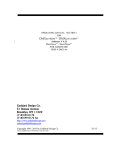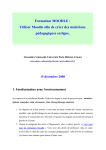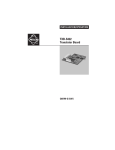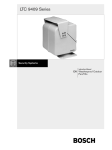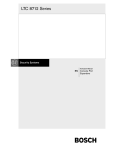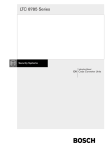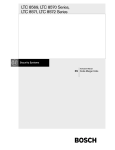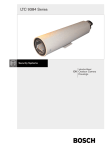Download Bosch LTC 5104 Instruction manual
Transcript
LTC 5104, LTC 5108 Series Instruction Manual EN 4- and 8-Position Premium Sequential Switchers LTC 5104, LTC 5108 Series | Instruction Manual | Important Safeguards EN | 2 Important Safeguards 1. Read, Follow, and Retain Instructions - All safety and operating instructions should be read and followed before operating the unit. Retain instructions for future reference. 2. Heed Warnings – Adhere to all warnings on the unit and in the operating instructions. 3. Attachments - Attachments not recommended by the product manufacturer should not be used, as they may cause hazards. 4. Installation Cautions - Do not place this unit on an unstable stand, tripod, bracket, or mount. The unit may fall, causing serious injury to a person and serious damage to the unit. Use only manufacturerrecommended accessories, or those sold with the product. Mount the unit per the manufacturer's instructions. Appliance and cart combination should be moved with care. Quick stops, excessive force, or uneven surfaces may cause the appliance and cart combination to overturn. 5. Cleaning - Unplug the unit from the outlet before cleaning. Follow any instructions provided with the unit. Generally, using a damp cloth for cleaning is sufficient. Do not use liquid cleaners or aerosol cleaners. 6. Servicing - Do not attempt to service this unit yourself. Opening or removing covers may expose you to dangerous voltage or other hazards. Refer all servicing to qualified service personnel. 7. Damage Requiring Service - Unplug the unit from the main AC power source and refer servicing to qualified service personnel under the following conditions: • When the power supply cord or plug is damaged. • If liquid has been spilled or an object has fallen into the unit. • If the unit has been exposed to water and/or inclement weather (rain, snow, etc.). • If the unit does not operate normally, when following the operating instructions. Adjust only those controls specified in the operating instructions. Improper adjustment of other controls may result in damage, and require extensive work by a qualified technician to restore the unit to normal operation. • If the unit has been dropped or the cabinet damaged. • If the unit exhibits a distinct change in performance, this indicates that service is needed. 8. Replacement Parts - When replacement parts are required, the service technician should use replacement parts specified by the manufacturer, or that have the same characteristics as the original part. Unauthorized substitutions may result in fire, electrical shock, or other hazards. 9. Safety Check - Upon completion of servicing or repairs to the unit, ask the service technician to perform safety checks to ensure proper operating condition. Bosch Security Systems | 7 April 2004 10. Power Sources - Operate the unit only from the type of power source indicated on the label. If unsure of the type of power supply to use, contact your dealer or local power company. • For units intended to operate from battery power, refer to the operating instructions. • For units intended to operate with External Power Supplies, use only the recommended approved power supplies. • For units intended to operate with a limited power source, this power source must comply with EN60950. Substitutions may damage the unit or cause fire or shock. • For units intended to operate at 24 VAC, normal input voltage is 24 VAC. Voltage applied to the unit's power input should not exceed 30 VAC. User-supplied wiring, from the 24 VAC supply to unit, must be in compliance with electrical codes (Class 2 power levels). Do not ground the 24 VAC supply at the terminals or at the unit's power supply terminals. 11. Coax Grounding - If an outside cable system is connected to the unit, ensure that the cable system is grounded. U.S.A. models only--Section 810 of the National Electrical Code, ANSI/NFPA No. 70, provides information regarding proper grounding of the mount and supporting structure, grounding of the coax to a discharge unit, size of grounding conductors, location of discharge unit, connection to grounding electrodes, and requirements for the grounding electrode. 12. Grounding or Polarization - This unit may be equipped with a polarized alternating current line plug (a plug with one blade wider than the other). This safety feature allows the plug to fit into the power outlet in only one way. If unable to insert the plug fully into the outlet, try reversing the plug. If the plug still fails to fit, contact an electrician to arrange replacement of the obsolete outlet. Do not defeat the safety purpose of the polarized plug. Alternately, this unit may be equipped with a 3-wire grounding plug (a plug with a third pin, for grounding). This safety feature allows the plug to fit into a grounding power outlet only. If unable to insert the plug into the outlet, contact an electrician to arrange replacement of the obsolete outlet. Do not defeat the safety purpose of the grounding plug. 13. Lightning - For added protection during a lightning storm, or when this unit is left unattended and unused for long periods of time, unplug the unit from the wall outlet and disconnect the cable system. This will prevent damage to the unit due to lightning and power line surges. EN | 3 LTC 5104, LTC 5108 Series | Instruction Manual | Safety Precautions For Indoor Product 1. Water and Moisture - Do not use this unit near water - for example, in a wet basement, in an unprotected outdoor installation, or in any area classified as a wet location. 2. Object and Liquid Entry - Never push objects of any kind into this unit through openings, as they may touch dangerous voltage points or short out parts that could result in a fire or electrical shock. Never spill liquid of any kind on the unit. 3. Power Cord and Power Cord Protection - For units intended to operate with 230 VAC, 50 Hz, the input and output power cord must comply with the latest versions of IEC Publication 227 or IEC Publication 245. Power supply cords should be routed so they are not likely to be walked on or pinched. Pay particular attention to location of cords and plugs, convenience receptacles, and the point of exit from the appliance. 4. Overloading - Do not overload outlets and extension cords; this can result in a risk of fire or electrical shock. For Outdoor Product Power Lines - An outdoor system should not be located in the vicinity of overhead power lines, electric lights, or power circuits, or where it may contact such power lines or circuits. When installing an outdoor system, extreme care should be taken to keep from touching power lines or circuits, as this contact might be fatal. U.S.A. models only - refer to the National Electrical Code Article 820 regarding installation of CATV systems. For Rack-Mount Product 1. Ventilation - This unit should not be placed in a built-in installation or rack, unless proper ventilation is provided, or the manufacturer’s instructions have been adhered to. The equipment must not exceed its maximum operating temperature requirements. 2. Mechanical Loading - Mounting of the equipment in a rack shall be such that a hazardous condition is not achieved due to uneven mechanical loading. Bosch Security Systems | 7 April 2004 Safety Precautions CAUTION: TO REDUCE THE RISK OF ELECTRIC SHOCK, DO NOT REMOVE COVER (OR BACK). NO USER SERVICEABLE PARTS INSIDE. REFER SERVICING TO QUALIFIED SERVICE PERSONNEL. The lightning flash with an arrowhead symbol, within an equilateral triangle, is intended to alert the user to the presence of uninsulated “dangerous voltage” within the product’s enclosure that may be of sufficient magnitude to constitute a risk of electric shock to persons. The exclamation point within an equilateral triangle is intended to alert the user to the presence of important operating and maintenance (servicing) instructions in the literature accompanying the appliance. Attention: Installation should be performed by qualified service personnel only in accordance with the National Electrical Code or applicable local codes. Power Disconnect. Units with or without ONOFF switches have power supplied to the unit whenever the power cord is inserted into the power source; however, the unit is operational only when the ON-OFF switch is in the ON position. The power cord is the main power disconnect for all units. EN | 4 LTC 5104, LTC 5108 Series | FCC & ICES Information FCC & ICES INFORMATION (U.S.A. and Canadian Models Only) This device complies with part 15 of the FCC Rules. Operation is subject to the following two conditions: (1) This device may not cause harmful interference, and (2) This device must accept any interference received, including interference that may cause undesired operation. NOTE: This equipment has been tested and found to comply with the limits for a Class B digital device, pursuant to Part 15 of the FCC Rules and ICES-003 of Industry Canada. These limits are designed to provide reasonable protection against harmful interference when the equipment is operated in a residential installation. This equipment generates, uses and can radiate radio frequency energy, and if not installed and used in accordance with the instructions, may cause harmful interference to radio communications. However, there is no guarantee that interference will not occur in a particular installation. If this equipment does cause harmful interference to radio or television reception, which can be determined by turning the equipment off and on, the user is encouraged to try to correct the interference by one or more of the following measures: • Reorient or relocate the receiving antenna. • Increase the separation between the equipment and receiver. • Connect the equipment into an outlet on a circuit different from that to which the receiver is connected. • Consult the dealer, or an experienced radio/TV technician for help. Intentional or unintentional changes or modifications, not expressly approved by the party responsible for compliance, shall not be made. Any such changes or modifications could void the user’s authority to operate the equipment. The user may find the following booklet, prepared by the Federal Communications Commission, helpful: How to Identify and Resolve Radio-TV Interference Problems. This booklet is available from the U.S. Government Printing Office, Washington, DC 20402, Stock No. 004-000-00345-4. Bosch Security Systems | 7 April 2004 Sécurité ATTENTION : POUR ÉVITER TOUT RISQUE D’ÉLECTROCUTION, NE PAS OUVRIR LE BOÎTIER. IL N’Y A PAS DE PIÈCES REMPLAÇABLES À L’INTÉRIEUR. POUR TOUTE INTERVENTION, S’ADRESSER À UN RÉPARATEUR PROFESSIONNEL COMPÉTENT. L’éclair fléché dans un triangle équilatéral avertit l’utilisateur de la présence d’une « tension dangereuse » non isolée à l’intérieur de l’appareil et d’une valeur suffisante pour constituer un risque d’électrocution. Le point d’exclamation contenu dans un triangle équilatéral avertit l’utilisateur de la présence, dans la documentation qui accompagne l’appareil, d’importantes consignes d’utilisation et de maintenance. Attention : L’installation doit être exclusivement effectuée par un technicien spécialisé conformément à la réglementation du code national de l’électricité des États-Unis (NEC) ou à la réglementation locale. Coupure de l’alimentation. Les appareils avec ou sans commutateur ON-OFF (marche-arrêt) sont alimentés dès que le cordon d’alimentation est branché à la source d’alimentation ; toutefois, les appareils disposant d’un commutateur de marche-arrêt ne fonctionnent que lorsque celui-ci est sur la position ON (marche). Le cordon d’alimentation est l’organe de coupure principal de l’alimentation pour tous les appareils. EN | 5 LTC 5104, LTC 5108 Series | Instruction Manual | Safety Precautions Sicherheitshinweise VORSICHT: DAS GEHÄUSE ZUR VERMEIDUNG VON ELEKTRISCHEN SCHLÄGEN NICHT ÖFFNEN. DAS GERÄT ENTHÄLT KEINE VOM BENUTZER ZU WARTENDEN TEILE. REPARATUREN NUR VON FACHPERSONAL AUSFÜHREN LASSEN. Das Blitzsymbol im gleichseitigen Dreieck soll den Benutzer auf nicht isolierte “gefährliche Spannung” im Produkt hinweisen, die ausreichend stark sein kann, um die Gefahr von elektrischen Schlägen für Menschen darzustellen. Das Ausrufungszeichen im gleichseitigen Dreieck soll den Benutzer auf wichtige Bedienungs- und Wartungsanweisungen in der Dokumentation hinweisen, die dem Gerät beiliegt. Achtung: Die Installation darf nur von qualifiziertem Wartungspersonal gemäß dem National Electrical Code oder den gültigen örtlichen Vorschriften durchgeführt werden. Abtrennen der Spannungsversorgung: Die Spannungsversorgung zu Geräten mit und ohne Ein/Aus-Schalter ist hergestellt, wenn das Netzkabel an eine Netzsteckdose angeschlossen ist. Das Gerät ist jedoch nur betriebsbereit, wenn der Ein/Aus-Schalter eingeschaltet ist. Bei allen Geräten erfolgt das Abtrennen der Spannungsversorgung über das Netzkabel. Bosch Security Systems | 7 April 2004 Precauciones de Seguridad PRECAUCIÓN: PARA REDUCIR EL RIESGO DE DESCARGA ELÉCTRICA, NO ABRA LAS TAPAS. EN EL INTERIOR NO HAY NINGÚN COMPONENTE REPARABLE POR EL USUARIO. LAS REPARACIONES DEBE REALIZARLAS PERSONAL CUALIFICADO. El símbolo de flecha en forma de rayo situado dentro de un triángulo equilátero pretende alertar al usuario de la presencia de “voltaje peligroso” sin aislamiento dentro de la caja del producto, el cual podría resultar de una magnitud suficiente como para presentar un riesgo de descarga eléctrica para las personas. El punto de exclamación dentro de un triángulo equilátero pretende alertar al usuario de la existencia de instrucciones de funcionamiento y mantenimiento (reparación) en la documentación suministrada con el aparato. Atención: La instalación debe realizarla personal cualificado en cumplimiento estricto del código eléctrico nacional (en el caso de los EE.UU.) o de los códigos locales aplicables. Para Desconectar la Alimentación: Unidades no equipadas con interruptores ON/OFF, son alimentadas cuando el cable de alimentación es conectado a la corriente eléctrica. Las unidades equipadas con interruptores son alimentadas de igual forma, pero adicionalmente requieren que el interruptor esté posicionado en ON. El cable de alimentación es el medio principal de desconexión del equipo. EN | 6 LTC 5104, LTC 5108 Series | Instruction Manual | Safety Precautions Veiligheidsmaatregelen GEVAAR: OPEN DEZE BEHUIZING NIET, TENEINDE HET RISICO VAN ELEKTRISCHE SCHOKKEN TE VOORKOMEN. BINNENIN BEVINDEN ZICH GEEN DOOR DE GEBRUIKER TE REPAREREN ONDERDELEN. RAADPLEEG VOOR REPARATIE GEKWALIFICEERD SERVICEPERSONEEL. Het symbool van een bliksem met pijlpunt in een gelijkzijdige driehoek is bedoeld om de gebruiker te waarschuwen voor de aanwezigheid van een niet geïsoleerde ‘gevaarlijke spanning’ binnen in de behuizing van het product, die voldoende sterk kan zijn om personen het risico van een elektrische schok te geven. Het symbool van een uitroepteken in een gelijkzijdige driehoek is bedoeld om de gebruiker te waarschuwen voor de aanwezigheid van belangrijke bedieningsen onderhouds- (service-) instructies in de documentatie die met het product zijn meegeleverd. Attentie: De installatie dient alleen te worden uitgevoerd door gekwalificeerd servicepersoneel en in overeenstemming met de plaatselijk geldende installatievoorschriften. Onderbreken van de spanning. Units met of zonder AAN/UIT-schakelaar, staan onder spanning zolang het netsnoer is verbonden met de wandcontactdoos. De unit is echter alleen bedrijfsklaar als de AAN/UIT-schakelaar in de AAN-stand staat. Losnemen van het netsnoer is voor alle units de belangrijkste manier om de spanning te onderbreken. Bosch Security Systems | 7 April 2004 Sicurezza ATTENZIONE: PER RIDURRE IL PERICOLO DI SCOSSA ELETTRICA, NON APRIRE LE COPERTURE. L’INTERNO NON CONTIENE COMPONENTI CHE L’UTENTE PUÒ RIPARARE PERSONALMENTE. RIVOLGERSI AL PERSONALE DI ASSISTENZA QUALIFICATO PER QUALSIASI INTERVENTO DI RIPARAZIONE. Il simbolo triangolare di un fulmine con la punta a freccia intende mettere in allerta l’utente riguardo alla presenza di tensioni pericolose non isolate all’interno del guscio dell’unità, che potrebbero essere di intensità sufficiente per costituire pericolo di elettrocuzione. Il punto esclamativo racchiuso in un triangolo equilatero intende avvisare l’utente in merito alla presenza di importanti istruzioni operative e di manutenzione nella documentazione di accompagnamento all’unità. Precauzione: affidare l’installazione al solo personale qualificato e nel rispetto del Codice elettrico nazionale (USA) o dei codici locali pertinenti. Scollegamento dell’alimentazione. Gli apparecchi con o senza commutatori ON-OFF ricevono corrente tutte le volte che il cavo di alimentazione è inserito nella presa di forza; tuttavia, gli apparecchi muniti di commutatore ON-OFF funzionano solo se quest’ultimo è in posizione ON. Il cavo di alimentazione serve a scollegare dalla corrente tutti gli apparecchi. LTC 5104, LTC 5108 Series | Instruction Manual | Table of Contents EN | 7 Table of Contents Important Safeguards . . . . . . . . . . . . . . . . . . . . . . . . . . . . . . . . . . . . . . . . . . . . . . . . . . . . . . . . . . . . . . . . . . . . .2 FCC & ICES Information . . . . . . . . . . . . . . . . . . . . . . . . . . . . . . . . . . . . . . . . . . . . . . . . . . . . . . . . . . . . . . . . . .4 1 UNPACKING . . . . . . . . . . . . . . . . . . . . . . . . . . . . . . . . . . . . . . . . . . . . . . . . . . . . . . . . . . . . . . . . . . . . .8 2 SERVICE . . . . . . . . . . . . . . . . . . . . . . . . . . . . . . . . . . . . . . . . . . . . . . . . . . . . . . . . . . . . . . . . . . . . . . . . .8 3 DESCRIPTION . . . . . . . . . . . . . . . . . . . . . . . . . . . . . . . . . . . . . . . . . . . . . . . . . . . . . . . . . . . . . . . . . . . .8 4 INSTALLATION . . . . . . . . . . . . . . . . . . . . . . . . . . . . . . . . . . . . . . . . . . . . . . . . . . . . . . . . . . . . . . . . . . .8 4.1 Power . . . . . . . . . . . . . . . . . . . . . . . . . . . . . . . . . . . . . . . . . . . . . . . . . . . . . . . . . . . . . . . . . . . . . . . . . . . .8 4.2 Mounting . . . . . . . . . . . . . . . . . . . . . . . . . . . . . . . . . . . . . . . . . . . . . . . . . . . . . . . . . . . . . . . . . . . . . . . . .8 4.3 Video Inputs and Looping Outputs . . . . . . . . . . . . . . . . . . . . . . . . . . . . . . . . . . . . . . . . . . . . . . . . . . . . .8 4.4 Monitor Output . . . . . . . . . . . . . . . . . . . . . . . . . . . . . . . . . . . . . . . . . . . . . . . . . . . . . . . . . . . . . . . . . . . .8 4.5 Alarm Inputs and Output (Accessory Output) . . . . . . . . . . . . . . . . . . . . . . . . . . . . . . . . . . . . . . . . . . . . .9 4.6 Programming System Setup . . . . . . . . . . . . . . . . . . . . . . . . . . . . . . . . . . . . . . . . . . . . . . . . . . . . . . . . . . .9 4.7 Resetting to Default Programming . . . . . . . . . . . . . . . . . . . . . . . . . . . . . . . . . . . . . . . . . . . . . . . . . . . . . .9 4.8 Dwell Time . . . . . . . . . . . . . . . . . . . . . . . . . . . . . . . . . . . . . . . . . . . . . . . . . . . . . . . . . . . . . . . . . . . . . . .10 4.9 Operating Mode LTC 5108 Series Only . . . . . . . . . . . . . . . . . . . . . . . . . . . . . . . . . . . . . . . . . . . . . . . . .10 4.10 Alarm Reset Mode . . . . . . . . . . . . . . . . . . . . . . . . . . . . . . . . . . . . . . . . . . . . . . . . . . . . . . . . . . . . . . . . .10 4.11 Alarm Capture . . . . . . . . . . . . . . . . . . . . . . . . . . . . . . . . . . . . . . . . . . . . . . . . . . . . . . . . . . . . . . . . . . . .11 4.12 Alarm Capture Time . . . . . . . . . . . . . . . . . . . . . . . . . . . . . . . . . . . . . . . . . . . . . . . . . . . . . . . . . . . . . . .11 4.13 Alarm Dwell Time . . . . . . . . . . . . . . . . . . . . . . . . . . . . . . . . . . . . . . . . . . . . . . . . . . . . . . . . . . . . . . . . .11 4.14 Alarm Contact Closures . . . . . . . . . . . . . . . . . . . . . . . . . . . . . . . . . . . . . . . . . . . . . . . . . . . . . . . . . . . . .11 4.15 Status Line . . . . . . . . . . . . . . . . . . . . . . . . . . . . . . . . . . . . . . . . . . . . . . . . . . . . . . . . . . . . . . . . . . . . . . .12 4.16 Screen Display Brightness and Background . . . . . . . . . . . . . . . . . . . . . . . . . . . . . . . . . . . . . . . . . . . . . .12 4.17 Screen Display Position . . . . . . . . . . . . . . . . . . . . . . . . . . . . . . . . . . . . . . . . . . . . . . . . . . . . . . . . . . . . .12 4.18 Programming Camera Titles . . . . . . . . . . . . . . . . . . . . . . . . . . . . . . . . . . . . . . . . . . . . . . . . . . . . . . . . . .12 5 OPERATION . . . . . . . . . . . . . . . . . . . . . . . . . . . . . . . . . . . . . . . . . . . . . . . . . . . . . . . . . . . . . . . . . . . . .13 5.1 DWELL Key . . . . . . . . . . . . . . . . . . . . . . . . . . . . . . . . . . . . . . . . . . . . . . . . . . . . . . . . . . . . . . . . . . . . . .13 5.2 SKIP/clr Key . . . . . . . . . . . . . . . . . . . . . . . . . . . . . . . . . . . . . . . . . . . . . . . . . . . . . . . . . . . . . . . . . . . . .13 5.3 ALARM Key . . . . . . . . . . . . . . . . . . . . . . . . . . . . . . . . . . . . . . . . . . . . . . . . . . . . . . . . . . . . . . . . . . . . .13 5.4 RUN/next Key . . . . . . . . . . . . . . . . . . . . . . . . . . . . . . . . . . . . . . . . . . . . . . . . . . . . . . . . . . . . . . . . . . . .13 5.5 Numeric Channel Keys . . . . . . . . . . . . . . . . . . . . . . . . . . . . . . . . . . . . . . . . . . . . . . . . . . . . . . . . . . . . .13 6 ILLUSTRATIONS . . . . . . . . . . . . . . . . . . . . . . . . . . . . . . . . . . . . . . . . . . . . . . . . . . . . . . . . . . . . . . . . .14 6.1 LTC 5104 Series . . . . . . . . . . . . . . . . . . . . . . . . . . . . . . . . . . . . . . . . . . . . . . . . . . . . . . . . . . . . . . . . . . .14 6.2 LTC 5108 Series . . . . . . . . . . . . . . . . . . . . . . . . . . . . . . . . . . . . . . . . . . . . . . . . . . . . . . . . . . . . . . . . . . .15 7 FONT TABLES . . . . . . . . . . . . . . . . . . . . . . . . . . . . . . . . . . . . . . . . . . . . . . . . . . . . . . . . . . . . . . . . . . .17 Bosch Security Systems | 7 April 2004 EN | 8 LTC 5104, LTC 5108 Series | Instruction Manual | Unpacking 1 UNPACKING Unpack carefully. This is electronic equipment and should be handled with care. 4 INSTALLATION 4.1 Power Model Rated 1 Check for the following items: • Verify the unit model number. • One (1) cable assembly with 15-pin connector. If an item appears to have been damaged in shipment, replace it properly in its carton and notify the shipper. If any items are missing, notify your Bosch Security Systems, Inc. Sales Representative or Customer Service. The shipping carton is the safest container in which the unit may be transported. Save it for possible future use. 2 SERVICE If the unit ever needs repair service, the customer should contact the nearest Bosch Security Systems, Inc. Service Center for authorization to return and shipping instructions. Service Centers USA: Phone: 800-366-2283 or 717-735-6638 fax: 800-366-1329 or 717-735-6639 CCTV Spare Parts Phone: 800-894-5215 or 408-956-3853 or 3854 fax: 408-957-3198 e-Mail: [email protected] Canada: 514-738-2434 Europe, Middle East & Asia Pacific Region: 32-1-440-0711 For additional information, see www.boschsecuritysystems.com. DESCRIPTION The LTC 5104 Series and LTC 5108 Series are automatic sequential video switchers. The LTC 5104 Series have 4-camera inputs and 1-monitor output; the LTC 5108 Series have 8-camera inputs and 2-monitor outputs. Power at No. Voltage Range Rated Voltage LTC 5104/60 120 VAC, 50/60 Hz 105 to 130 4W LTC 5104/50 220-240 VAC, 50/60 Hz 198 to 264 4W LTC 5108/60 120 VAC, 50/60 Hz 105 to 130 4W LTC 5108/50 220-240 VAC, 50/60 Hz 198 to 264 4W 1 Models shown are for English on-screen menu model. The model number and operating voltage are shown on the bottom of the unit. These units are supplied with grounded power cords; grounding must not be defeated. 4.2 Mounting These switchers are half rack units and are supplied as desk top units. For rack mounting, the LTC 9101/00 rack-mount kit is available. 4.3 Video Inputs and Looping Outputs For each of the 4 or 8 channels, there are two BNC connectors on the rear panel. One of these connectors is to be used as a video input while the other connector may be used as a looping output. It does not matter which connector is used as the input and which is used as the looping output. Each pair of BNCs provides an automatic termination function that applies a 75 Ω load to the incoming video signal when the cable is connected to either jack. When "loop-through" operation is desired, the second cable connection automatically unterminates the input providing the required high impedance for "loop-through" operation. The jacks act as automatic switches. The looping video outputs are provided to supply video to other video equipment. When looping, the last piece of equipment on the video line should be terminated. 4.4 3 Voltage Monitor Output The monitor outputs are designed for a 75 Ω load. Therefore, when looping the monitor output cable through multiple monitors or their accessories, ensure their terminations are set to Hi-Z. Only the last unit on the line should have its termination set to 75 Ω. LTC 5104 Series: A single monitor output permits switched camera video through this connection. LTC 5108 Series: These switchers may be used with one or two monitors, depending on system requirements. See Operating Mode section and Typical Installation illustration. Bosch Security Systems | 7 April 2004 EN | 9 LTC 5104, LTC 5108 Series | Instruction Manual | Installation 4.5 Alarm Inputs and Output (Accessory Output) A cable with a connector is supplied to connect alarm closures or other accessories to the switcher. The remaining configuration menus (8 for the LTC 5104 Series and 9 for the LTC 5108 Series) are also accessed with the DWELL key. With video present on the monitor, press and hold the DWELL key for 1 second; the monitor will display SCREEN 2. The alarm inputs can be triggered by either a contact closure selectable normally open or closed (e.g., switch or relay) to ground or by a logic ground (e.g., motion detector output). The alarm output creates a short between the two output pins when an alarm occurs and open circuits the pins when no alarms are active (triggered). The alarm output has a maximum carrying current of 1 A and a maximum switching voltage of 40 V AC/DC. The alarm output can be used to signal a VCR, lamp, or relay. Screen 2 CAUTION: Do not apply external voltages to the alarm inputs. Use only isolated closures. Precautions should be taken particularly on long runs to prevent pickup of spurious signals from associated wiring, which may give false inputs or damage the switcher. 4.6 Programming System Setup Configuration options are provided through on-screen menus. These menus are accessed by using the DWELL key. With video present on the monitor, a momentary press and release of the DWELL key will gain easy access to the Dwell Time Menu (see SCREEN 1). Screen 1 Bosch Security Systems | 7 April 2004 To advance through these seven or eight menus, press RUN/next. When the last menu is displayed, RUN/next automatically exits the configuration mode. The configuration mode also exits automatically if there is no activity for 60 seconds. Use DWELL again to exit the configuration mode immediately. Any changes made during configuration are acknowledged regardless of how the configuration mode is exited. 4.7 Resetting to Default Programming To restore factory default program settings, press and hold SKIP/clr and then press the ALARM key for one second (see SCREEN 3). Screen 3 EN | 10 LTC 5104, LTC 5108 Series | Instruction Manual | Installation • To abort and resume normal operation, press DWELL. 4.9 • To reset to factory defaults, press SKIP/clr, moving the cursor to RESET, then press DWELL. This option also performs a VideoSearch. Two modes of operation can be selected for the LTC 5108 Series switchers (see SCREEN 2). The two modes only affect Monitor B; Monitor A continuously sequences regardless of mode. In the Sequencing Mode, Monitor B will show either an alarm call up of a camera, a camera under a Hold condition, or normal sequencing of cameras. In the Blanking Mode, Monitor B will show either an alarm call up of a camera, a camera under a Hold condition, or a blank screen. NOTE: Resetting the unit to factory defaults will not reset the title characters to be blank. 4.8 Dwell Time This menu (see SCREEN 1) is used to program dwell times of 1 second to 64 seconds for the cameras. There are two modes of dwell that may be chosen; All Cameras and Individual Cameras. All Cameras mode sets the displayed dwell time for all four or eight cameras. Individual Cameras mode sets the displayed dwell time for only the camera number indicated on-screen. Upon entry into the Dwell Time menu, the dwell mode defaults to All Cameras. The Individual Cameras mode is entered using the numeric keys or the RUN/next key. RUN/next key selects individual camera dwell times by sequencing forward. Each numeric key selects that particular camera input. The video of the selected individual camera will be displayed (on the monitor for LTC 5104 Series, or on both monitors for the LTC 5108 Series), provided the camera input has not been skipped. If a camera input is skipped, its dwell time menu can be entered but the unit will not switch video to that camera input. Since no dwell menu can be displayed if there is no video to that input, it is recommended to skip all camera inputs without video before attempting to set individual dwell times. Once in Individual mode, the Dwell Time menu must be exited and re-entered if All Cameras mode is desired. SKIP/clr decreases displayed dwell time, and ALARM increases dwell time. The default is All Cameras with a dwell of three seconds. Operating Mode LTC 5108 Series Only Operating Modes Monitor A Sequencing Mode 1. Normal sequencing of camera inputs 1. Normal sequencing (same as Monitor A) 2. HOLD condition 3. ALARM condition Blanking Mode 1. Normal sequencing of camera inputs 1. Blank screen 2. HOLD condition 3. ALARM condition 4.10 Alarm Reset Mode There are two Alarm Reset modes, AUTO and MANUAL (see SCREEN 4). In the AUTO reset mode, alarm call ups automatically reset after the Alarm Capture Time has expired. In the MANUAL reset mode, alarm call ups are held until manually reset via SKIP/clr. SKIP/clr toggles the selection pointer between the two modes. The default is AUTO. Screen 4 Bosch Security Systems | 7 April 2004 Monitor B LTC 5104, LTC 5108 Series | Instruction Manual | Installation EN | 11 4.11 Alarm Capture 4.13 Alarm Dwell Time This menu item appears only if the Auto Alarm reset mode is selected (see SCREEN 5). When the Alarm Capture is ON, alarm call ups are held for at least the length of their Alarm Capture Time. After its Alarm Capture Time has expired, the alarm call up remains as long as its contact closure exists. When the Alarm Capture is OFF, alarm call ups are held only as long as its contact closure is detected. The default is ON. The Alarm Dwell Time determines how long each alarm call up is displayed during sequencing of multiple alarms (see SCREEN 7). Use SKIP/clr to decrease time and ALARM to increase time. Alarm Dwell Time can be set from 1 second to 64 seconds. The default time is two seconds. Screen 7 Screen 5 4.12 Alarm Capture Time This menu item appears only when the Alarm Capture is ON (see SCREEN 6). The Capture Time specifies the minimum length of time that the alarm call up will be held, once its contact closure is detected. During multiple alarms, the Capture Time expires only while the alarm is being displayed. Use SKIP/clr to decrease time and ALARM to increase time. Alarm capture time can be set from 1 second to 63 seconds. The default time is 14 seconds. 4.14 Alarm Contact Closures This screen enables the user to set alarm contact closures as NORMALLY OPEN or NORMALLY CLOSED. Press SKIP/clr to choose between the two options. The default is NORMALLY OPEN (see SCREEN 8). Screen 8 Screen 6 Bosch Security Systems | 7 April 2004 EN | 12 LTC 5104, LTC 5108 Series | Instruction Manual | Installation 4.15 Status Line 4.17 Screen Display Position This menu determines what will be displayed on the on-screen Status Line. There are three options: 1. A full status line, which contains the camera number, camera title, sequence mode, and alarm status information, 2. Camera number and title only, or 3. Nothing at all (see SCREEN 9). SKIP/clr toggles the selection pointer of the modes. The default is a full status line. The display may be positioned both horizontally and vertically (see SCREEN 11). The numeric 1 key is used to move the display up, 2 to move down, 3 to move left and 4 to move right. The default is bottom center of the monitor screen. Screen 11 4.18 Programming Camera Titles Screen 9 CAUTION: Selecting the status line option other than the full status does not display the word ALARM on the video. With video present, access the Title Programming menu by pressing and holding RUN/next then pressing the numeric 3 key (see SCREEN 12). 4.16 Screen Display Brightness and Background The display brightness may be adjusted over seven levels from black to white (see SCREEN 10). The display background may be selected as silhouette (profile), no silhouette (no profile), or block format. Use SKIP/clr to make the display lighter, and ALARM darkens the display. When the end of the brightness range has been reached, the background format will toggle. The default background is silhouette. Screen 12 Once in the title setting screen: Screen 10 Bosch Security Systems | 7 April 2004 • To call up and program the title for a particular camera, enter the desired camera number via the numeric keys. This displays the entered camera # on all monitors (if video present). • To move the cursor on the title screen, press RUN/next. • To increment characters, press ALARM. • To decrement characters, press SKIP/clr. • To exit, press DWELL. EN | 13 LTC 5104, LTC 5108 Series | Instruction Manual | Installation NOTE: These functions can be performed at a faster speed by pressing and holding the respective keys for a few seconds. NOTE: For applicable characters, see SECTION 7, FONT TABLES. 5 OPERATION 5.1 DWELL Key DWELL is used to enter the Dwell Time configuration menu and to enter other menus. A momentary push will enter the Dwell Time menu. Holding DWELL for over one second will enter the program mode. 5.2 SKIP/clr Key SKIP/clr has two uses. The first use is to program which cameras will be in the switching sequence. This key toggles the displayed camera in or out of the sequence. An X will be lit to the left of the selected camera number if it is excluded from the sequence. Pressing SKIP/clr while a sequence is running immediately removes the camera from the sequence and advances to the next camera. An alarm closure on a skipped camera calls up that camera. This key also clears the displayed camera's alarm display. The cleared camera is not called up again until the alarm closure occurs again for that camera. 5.3 ALARM Key ALARM toggles the alarm function on and off. When the Alarm is on: • The alarm indicator LED is lit and the notation MA (Monitor Armed) appears on the status line (appears only on Monitor B for the LTC 5108 Series). • The switcher responds to all incoming alarms. During the alarm period, the word ALARM flashes on the status line, and the alarm LED flashes. When the Alarm is off: • The alarm indicator LED is not lit and no MA notation is present on the status line. When the alarm function is off, the switcher will not react to incoming alarms at that moment. Bosch Security Systems | 7 April 2004 5.4 RUN/next Key When multiple alarm call ups are present, RUN/next sequences to the next triggered camera. If no alarm call-ups are present and a hold is present, then the key removes that hold. Lastly, if there are no "holds" or alarm call ups, then by momentarily pressing the key, the sequence can be immediately advanced to the next camera input, or by continuously pressing the key, the sequence will rapidly sequence. The RUN/next LED lights whenever switchers are sequencing, and goes out whenever a HOLD is issued. 5.5 Numeric Channel Keys These keys will issue a hold on their respective camera inputs. The monitor (only Monitor B for the LTC 5108 Series) will stop sequencing (or BLANKING in the BLANKING mode) and display that camera's video until either: A. Another Numeric Channel key is pressed, or B. The RUN/next key is pressed, or C. An alarm call up occurs on another camera. If the Channel key is held down, the display of any cameras currently in an alarm condition can be overridden. EN | 14 LTC 5104, LTC 5108 Series | Instruction Manual | Illustrations 6 ILLUSTRATIONS 6.1 LTC 5104 Series Screen 13 Front Panel and Back Panel 1 6 11 2 7 12 3 8 13 4 9 14 5 10 15 Screen 14 Connector Diagram Bosch Security Systems | 7 April 2004 Pin 1 2 3 4 5 6 7 8 9 10 11 12 13 14 15 NC NO Function Ground Alarm 3 NC Reserved Reserved Alarm 1 Alarm 4 NC Alarm Relay (NO) Reserved Alarm 2 NC NC Alarm Relay (NO) Reserved No Connection Normally Open EN | 15 LTC 5104, LTC 5108 Series | Instruction Manual | Illustrations 6.2 LTC 5108 Series Screen 15 Front Panel and Back Panel 1 6 11 2 7 12 3 8 13 4 9 14 5 10 15 Screen 16 Connector Diagram Bosch Security Systems | 7 April 2004 Pin 1 2 3 4 5 6 7 8 9 10 11 12 13 14 15 Function Ground Alarm 3 Alarm 6 Monitor Strobe 1 Data 0 Alarm 1 Alarm 4 Alarm 7 Alarm Relay (NO) Data 1 Alarm 2 Alarm 5 Alarm 8 Alarm Relay (NO) Data 2 NO Normally Open EN | 16 LTC 5104, LTC 5108 Series | Instruction Manual | Illustrations DVR or VCR Screen 17 Typical Installation Using LTC 5108 Series Switcher Bosch Security Systems | 7 April 2004 LTC 5104, LTC 5108 Series | Instruction Manual | Font Tables 7 FONT TABLES Bosch Security Systems | 7 April 2004 EN | 17 LTC 5104, LTC 5108 Series | Instruction Manual | Bosch Security Systems | 7 April 2004 EN | 18 LTC 5104, LTC 5108 Series | Instruction Manual | Bosch Security Systems | 7 April 2004 EN | 19 Bosch Security Systems, Inc. 850 Greenfield Road Lancaster, PA 17601 USA Tel: 800-326-3270 Fax: 1-717-735-6560 www.boschsecuritysystems.com Bosch Security Systems B.V. P.O. Box 80002 5600 JB Eindhoven The Netherlands Tele +31 40 27 80000 © 2004 Bosch Security Systems GmbH 3935 890 05112 04-16 | April 7, 2004 | Data subject to change without notice. Bosch Security Systems Pte Ltd. 38C Jalan Pemimpin Singapore 577180 Republic of Singapore Tel: 65 (6) 319 3486






















